Ask a question from expert
Fundamental Perspectives of HAVAC
38 Pages10900 Words285 Views
Added on 2021-08-10
Fundamental Perspectives of HAVAC
Added on 2021-08-10
BookmarkShareRelated Documents
1
Abstract:
This report contains Fundamental Perspectives and argues how HAVAC is critical and
most important in our daily life. The paper lights up the facts and historical background
of Heating, Air Conditioning, Ventilation and Refrigeration. Segmented overview about
history, scientific advancement, manufacturers and Product Design and major
applications of HVAC are Discussed. In manufacturers international are considered
.Highly ranked companies are discussed along with their leading product in air
conditioning. Some of Products are discussed individually. In Applications this report
shows the versatility of overlapping branches of each filed and industry, science,
agriculture, medical and most important houses and offices. In short this report signifies
the fact that HVAC is meeting the new human Comfort level.
Abstract:
This report contains Fundamental Perspectives and argues how HAVAC is critical and
most important in our daily life. The paper lights up the facts and historical background
of Heating, Air Conditioning, Ventilation and Refrigeration. Segmented overview about
history, scientific advancement, manufacturers and Product Design and major
applications of HVAC are Discussed. In manufacturers international are considered
.Highly ranked companies are discussed along with their leading product in air
conditioning. Some of Products are discussed individually. In Applications this report
shows the versatility of overlapping branches of each filed and industry, science,
agriculture, medical and most important houses and offices. In short this report signifies
the fact that HVAC is meeting the new human Comfort level.
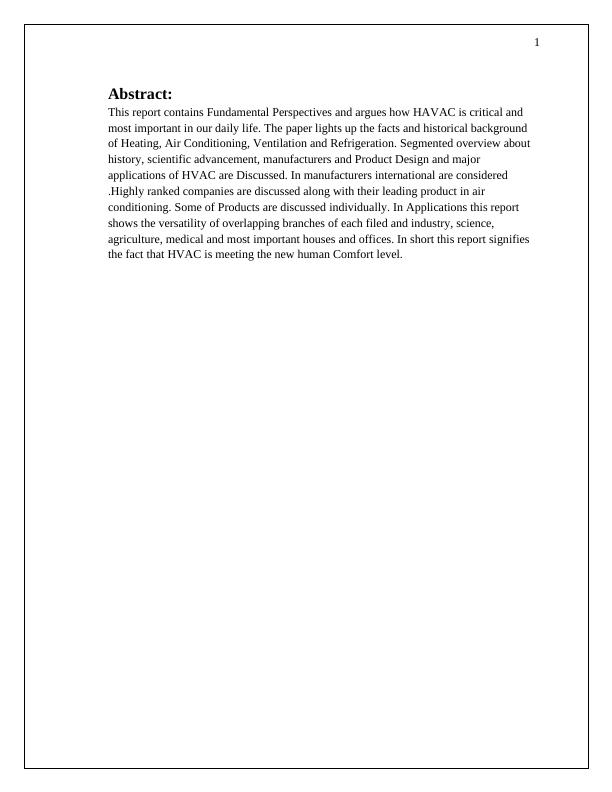
2
Contents
Abstract: ........................................................................................................................ 1
Introduction to Refrigeration and Air Conditioning (HVAC) .......................................... 5
1 HVAC: ........................................................................................................................ 5
1.1 Heating: ................................................................................................................ 5
1.2 Ventilation: ........................................................................................................... 5
1.3 Methods for ventilation; ....................................................................................... 6
1.3.1 Mechanical or Ventilation: ........................................................................... 6
1.3.2 Natural Ventilation: ...................................................................................... 6
1.4 Air-Conditioning: ................................................................................................. 6
1.5 Refrigeration: ....................................................................................................... 6
2 History of HVACR systems........................................................................................ 7
3 Technological Advancements in HVACR .................................................................. 8
3.1 Technological Advancements .............................................................................. 8
3.1.1 Learning Thermostat ..................................................................................... 8
3.1.2 Self-Diagnosis: .............................................................................................. 9
3.2 Variable-Speed Blowers ....................................................................................... 9
3.2.1 Smart Control Systems ............................................................................... 10
3.2.2 Mini-split Systems for Zoned Cooling. ...................................................... 11
3.2.3 Clean Air Technology ................................................................................. 11
3.2.4 Geothermal systems. ................................................................................... 12
3.2.5 Magnetic refrigeration ................................................................................ 13
3.2.6 Freeze Concentration Technology: ............................................................. 14
3.2.7 THE "ON COMMAND" HOT WATER RECIRCULATOR .................... 15
3.2.8 THERMALLY-DRIVEN AIR CONDITIONING ..................................... 15
3.2.9 THE ICE-POWERED AIR CONDITIONER ............................................ 16
3.2.10 Quiet Duct Wrap: ........................................................................................ 16
3.2.11 THE DUAL FUEL HEAT PUMP .............................................................. 17
4 Applications of Refrigeration & Air-Conditioning................................................... 17
4.1 Domestic Air-Conditioning: ............................................................................... 17
Contents
Abstract: ........................................................................................................................ 1
Introduction to Refrigeration and Air Conditioning (HVAC) .......................................... 5
1 HVAC: ........................................................................................................................ 5
1.1 Heating: ................................................................................................................ 5
1.2 Ventilation: ........................................................................................................... 5
1.3 Methods for ventilation; ....................................................................................... 6
1.3.1 Mechanical or Ventilation: ........................................................................... 6
1.3.2 Natural Ventilation: ...................................................................................... 6
1.4 Air-Conditioning: ................................................................................................. 6
1.5 Refrigeration: ....................................................................................................... 6
2 History of HVACR systems........................................................................................ 7
3 Technological Advancements in HVACR .................................................................. 8
3.1 Technological Advancements .............................................................................. 8
3.1.1 Learning Thermostat ..................................................................................... 8
3.1.2 Self-Diagnosis: .............................................................................................. 9
3.2 Variable-Speed Blowers ....................................................................................... 9
3.2.1 Smart Control Systems ............................................................................... 10
3.2.2 Mini-split Systems for Zoned Cooling. ...................................................... 11
3.2.3 Clean Air Technology ................................................................................. 11
3.2.4 Geothermal systems. ................................................................................... 12
3.2.5 Magnetic refrigeration ................................................................................ 13
3.2.6 Freeze Concentration Technology: ............................................................. 14
3.2.7 THE "ON COMMAND" HOT WATER RECIRCULATOR .................... 15
3.2.8 THERMALLY-DRIVEN AIR CONDITIONING ..................................... 15
3.2.9 THE ICE-POWERED AIR CONDITIONER ............................................ 16
3.2.10 Quiet Duct Wrap: ........................................................................................ 16
3.2.11 THE DUAL FUEL HEAT PUMP .............................................................. 17
4 Applications of Refrigeration & Air-Conditioning................................................... 17
4.1 Domestic Air-Conditioning: ............................................................................... 17
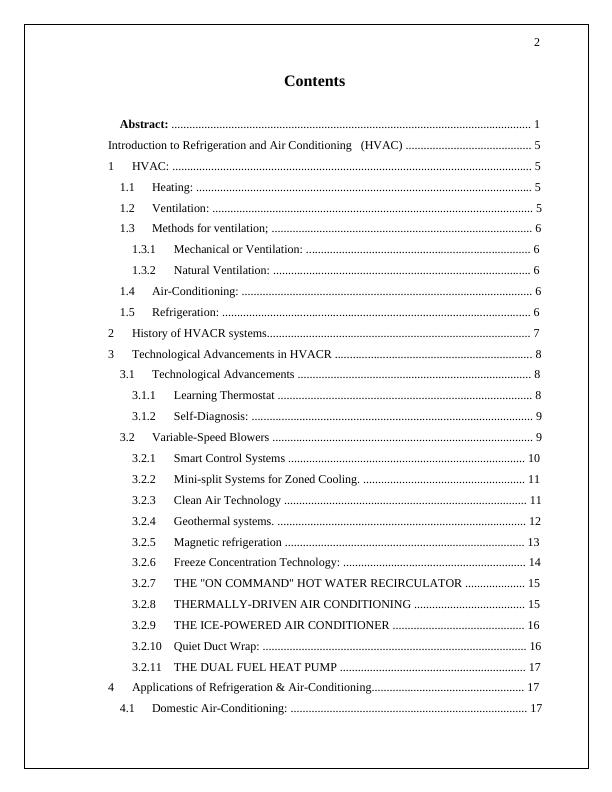
3
4.1.1 Spot Heating: .............................................................................................. 17
4.1.2 Spot Cooling ............................................................................................... 18
4.2 Industrial Air-Conditioning: ............................................................................... 18
4.3 Environmental Laboratories: .............................................................................. 18
4.4 Clean Rooms: ..................................................................................................... 19
4.5 Dark Rooms: ...................................................................................................... 20
4.6 Computer Room Air-Conditioning: ................................................................... 20
4.7 Power Plants: ...................................................................................................... 21
4.8 Residential Air-Conditioning: ............................................................................ 21
4.8.1 Window Air-Conditioner: ........................................................................... 21
4.8.2 Split Air-Conditioner: ................................................................................. 22
4.8.3 Indoor Unit: ................................................................................................. 22
4.8.4 Outdoor Unit: .............................................................................................. 22
4.9 Packaged Air Conditioner: ................................................................................. 23
4.9.1 Packaged Air Conditioners with Water Cooled Condenser:....................... 23
4.9.2 Packaged Air Conditioners with Air Cooled Condensers: ......................... 23
4.10 Central Air-Conditioner:................................................................................. 24
4.10.1 Direct expansion or DX central air conditioning plant: .............................. 24
4.10.2 Chilled water central air conditioning plant: .............................................. 24
4.11 Automobile Air-Conditioning: ....................................................................... 25
4.12 Food Industry:................................................................................................. 26
4.13 Temperature: ................................................................................................... 26
4.14 Air Distribution: ............................................................................................. 26
4.15 Ice Skating Rink: ............................................................................................ 27
5 Manufacturers of HVACR ........................................................................................ 28
5.1 International manufacturers................................................................................ 28
5.1.1 Carrier Corporation: .................................................................................... 29
5.1.2 Carrier products .......................................................................................... 29
5.1.3 Daikin Industries ......................................................................................... 30
5.1.4 Daikin products: .......................................................................................... 30
5.1.5 Hitachi ......................................................................................................... 31
4.1.1 Spot Heating: .............................................................................................. 17
4.1.2 Spot Cooling ............................................................................................... 18
4.2 Industrial Air-Conditioning: ............................................................................... 18
4.3 Environmental Laboratories: .............................................................................. 18
4.4 Clean Rooms: ..................................................................................................... 19
4.5 Dark Rooms: ...................................................................................................... 20
4.6 Computer Room Air-Conditioning: ................................................................... 20
4.7 Power Plants: ...................................................................................................... 21
4.8 Residential Air-Conditioning: ............................................................................ 21
4.8.1 Window Air-Conditioner: ........................................................................... 21
4.8.2 Split Air-Conditioner: ................................................................................. 22
4.8.3 Indoor Unit: ................................................................................................. 22
4.8.4 Outdoor Unit: .............................................................................................. 22
4.9 Packaged Air Conditioner: ................................................................................. 23
4.9.1 Packaged Air Conditioners with Water Cooled Condenser:....................... 23
4.9.2 Packaged Air Conditioners with Air Cooled Condensers: ......................... 23
4.10 Central Air-Conditioner:................................................................................. 24
4.10.1 Direct expansion or DX central air conditioning plant: .............................. 24
4.10.2 Chilled water central air conditioning plant: .............................................. 24
4.11 Automobile Air-Conditioning: ....................................................................... 25
4.12 Food Industry:................................................................................................. 26
4.13 Temperature: ................................................................................................... 26
4.14 Air Distribution: ............................................................................................. 26
4.15 Ice Skating Rink: ............................................................................................ 27
5 Manufacturers of HVACR ........................................................................................ 28
5.1 International manufacturers................................................................................ 28
5.1.1 Carrier Corporation: .................................................................................... 29
5.1.2 Carrier products .......................................................................................... 29
5.1.3 Daikin Industries ......................................................................................... 30
5.1.4 Daikin products: .......................................................................................... 30
5.1.5 Hitachi ......................................................................................................... 31
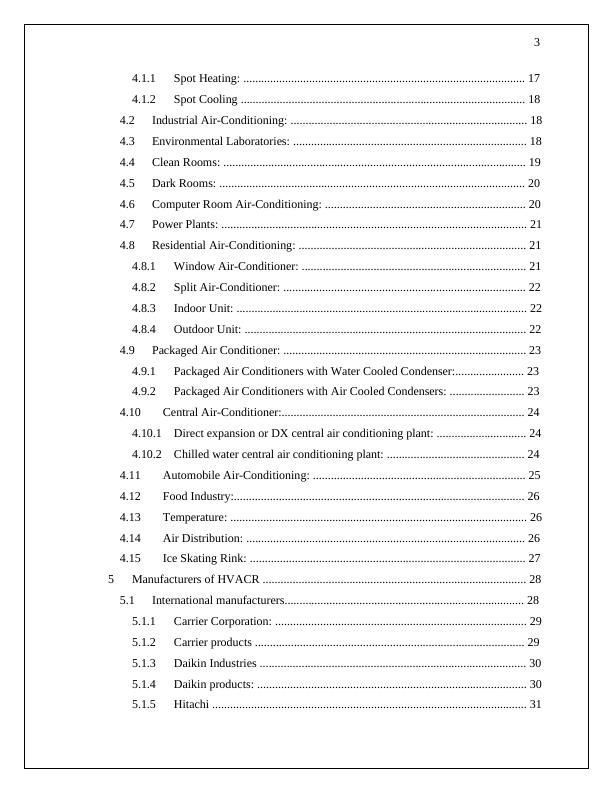
4
5.1.6 Blue Star...................................................................................................... 31
5.1.7 Whirlpool .................................................................................................... 31
5.1.8 Voltas .......................................................................................................... 32
5.1.9 LG ............................................................................................................... 32
5.1.10 Samsung ...................................................................................................... 32
5.1.11 Electrolux .................................................................................................... 32
5.1.12 O General .................................................................................................... 33
5.1.13 Videocon ..................................................................................................... 33
5.1.14 Affinity™ Series ......................................................................................... 33
5.1.15 YORK LX Series ........................................................................................ 33
5.1.16 The Lintern.................................................................................................. 33
5.1.17 McCrea ........................................................................................................ 34
5.1.18 Genius ......................................................................................................... 34
5.1.19 Haier ............................................................................................................ 34
5.1.20 Haier products: ............................................................................................ 34
5.2 Local Manufacturers .......................................................................................... 35
5.2.1 Teknika Corporation of Pakistan ................................................................ 35
5.2.2 TCP Products: ............................................................................................. 35
5.2.3 4.2.2 MECATECH ..................................................................................... 35
5.2.4 4.2.3 Seasonmaster Engineering Private Limited ....................................... 35
5.2.5 Air Control Engineering Services (ACES) ................................................. 36
5.2.6 S. Zia-Ul-Haq & Sons ................................................................................. 36
5.2.7 Residential and Commercial Services: ....................................................... 36
5.2.8 4.2.6 Nucon Engineers ................................................................................ 37
5.2.9 4.2.7 FORCE Engineering .......................................................................... 37
5.2.10 Venture Engineering (Pvt.) ......................................................................... 37
6 Future horizons of HVAC ......................................................................................... 38
7 References ................................................................................................................. 38
5.1.6 Blue Star...................................................................................................... 31
5.1.7 Whirlpool .................................................................................................... 31
5.1.8 Voltas .......................................................................................................... 32
5.1.9 LG ............................................................................................................... 32
5.1.10 Samsung ...................................................................................................... 32
5.1.11 Electrolux .................................................................................................... 32
5.1.12 O General .................................................................................................... 33
5.1.13 Videocon ..................................................................................................... 33
5.1.14 Affinity™ Series ......................................................................................... 33
5.1.15 YORK LX Series ........................................................................................ 33
5.1.16 The Lintern.................................................................................................. 33
5.1.17 McCrea ........................................................................................................ 34
5.1.18 Genius ......................................................................................................... 34
5.1.19 Haier ............................................................................................................ 34
5.1.20 Haier products: ............................................................................................ 34
5.2 Local Manufacturers .......................................................................................... 35
5.2.1 Teknika Corporation of Pakistan ................................................................ 35
5.2.2 TCP Products: ............................................................................................. 35
5.2.3 4.2.2 MECATECH ..................................................................................... 35
5.2.4 4.2.3 Seasonmaster Engineering Private Limited ....................................... 35
5.2.5 Air Control Engineering Services (ACES) ................................................. 36
5.2.6 S. Zia-Ul-Haq & Sons ................................................................................. 36
5.2.7 Residential and Commercial Services: ....................................................... 36
5.2.8 4.2.6 Nucon Engineers ................................................................................ 37
5.2.9 4.2.7 FORCE Engineering .......................................................................... 37
5.2.10 Venture Engineering (Pvt.) ......................................................................... 37
6 Future horizons of HVAC ......................................................................................... 38
7 References ................................................................................................................. 38

5
Figure 1.1 Representation of HVAC
Introduction to Refrigeration and Air Conditioning (HVAC)
1 HVAC:
HVAC (heating, ventilating/ventilation, and air conditioning) is the technology of indoor
and vehicular environmental comfort. Its goal is to provide thermal comfort and
acceptable indoor air quality. HVAC system design is a sub discipline of mechanical
engineering, based on the principles of thermodynamics, fluid mechanics, and heat
transfer. Refrigeration is sometimes added to the field's abbreviation as HVAC&R or
HVACR.
1.1 Heating:
Heating is the transfer of energy to space or to the air in the space by virtue of
temperature difference between source and the space or air. This process may take
different forms, such as direct radiation and free convection to the space, direct heating or
forced circulation of air or transfer of heated water to the vicinity of the space and used to
heat the circulated air. Heaters are appliances whose purpose is to generate heat (i.e.
warmth) for the building. This can be done via central heating.
1.2 Ventilation:
Ventilation is the process of changing or replacing air in any space to control temperature
or remove any combination of moisture, odors, smoke, heat, dust, airborne bacteria, or
carbon dioxide, and to replenish oxygen. Ventilation includes both the exchange of air
with the outside as well as circulation of air within the building. It is one of the most
important factors for maintaining acceptable indoor air quality in buildings.
Figure 1.1 Representation of HVAC
Introduction to Refrigeration and Air Conditioning (HVAC)
1 HVAC:
HVAC (heating, ventilating/ventilation, and air conditioning) is the technology of indoor
and vehicular environmental comfort. Its goal is to provide thermal comfort and
acceptable indoor air quality. HVAC system design is a sub discipline of mechanical
engineering, based on the principles of thermodynamics, fluid mechanics, and heat
transfer. Refrigeration is sometimes added to the field's abbreviation as HVAC&R or
HVACR.
1.1 Heating:
Heating is the transfer of energy to space or to the air in the space by virtue of
temperature difference between source and the space or air. This process may take
different forms, such as direct radiation and free convection to the space, direct heating or
forced circulation of air or transfer of heated water to the vicinity of the space and used to
heat the circulated air. Heaters are appliances whose purpose is to generate heat (i.e.
warmth) for the building. This can be done via central heating.
1.2 Ventilation:
Ventilation is the process of changing or replacing air in any space to control temperature
or remove any combination of moisture, odors, smoke, heat, dust, airborne bacteria, or
carbon dioxide, and to replenish oxygen. Ventilation includes both the exchange of air
with the outside as well as circulation of air within the building. It is one of the most
important factors for maintaining acceptable indoor air quality in buildings.
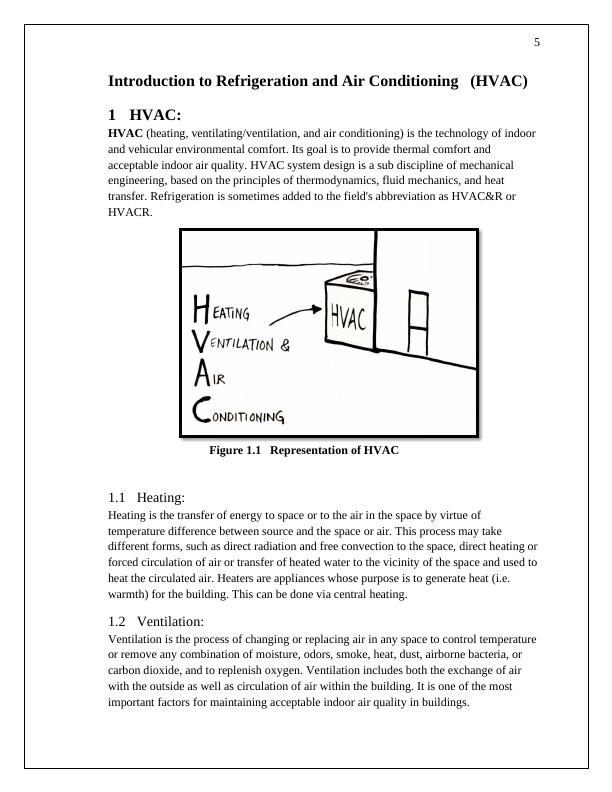
6
1.3 Methods for ventilation;
Mechanical or Forced Ventilation
Natural Ventilation
1.3.1 Mechanical or Ventilation:
Mechanical, or forced, ventilation is provided by an air handler and used to
control indoor air quality. Excess humidity, odors, and contaminants can often be
controlled via dilution or replacement with outside air.
1.3.2 Natural Ventilation:
Natural ventilation is the ventilation of a building with outside air without using fans or
other mechanical systems. It can be via operable windows, louvers, or trickle vents when
spaces are small and the architecture permits.
1.4 Air-Conditioning:
Air conditioning (often referred to as AC or A.C) is the process of altering the condition
of air by removing heat and humidity to achieve a more comfortable interior
environments, typically with the aim of distributing the conditioned air to an occupied
space such as a building or a vehicle to improve thermal comfort and indoor air quality.
In common use, an air conditioner is a device that removes heat from the air inside a
building or vehicle, thus lowering the air temperature. The cooling is typically achieved
through a refrigeration cycle, but sometimes evaporation or free cooling is used. Air
conditioning systems can also be made based on desiccants.
1.5 Refrigeration:
Refrigeration is a process of moving heat from one location to another in controlled
conditions. The work of heat transport is traditionally driven by mechanical work, but can
also be driven by heat, magnetism, electricity, laser, or other means. Refrigeration has
many applications, including, but not limited to: household refrigerators,
industrial freezers, cryogenics, and air. Heat pumps may use the heat output of the
refrigeration process, and also may be designed to be reversible, but are otherwise similar
to air conditioning units.
The refrigeration cycles are;
Vapor Compression Cycle
Vapor Absorption Cycle
1.3 Methods for ventilation;
Mechanical or Forced Ventilation
Natural Ventilation
1.3.1 Mechanical or Ventilation:
Mechanical, or forced, ventilation is provided by an air handler and used to
control indoor air quality. Excess humidity, odors, and contaminants can often be
controlled via dilution or replacement with outside air.
1.3.2 Natural Ventilation:
Natural ventilation is the ventilation of a building with outside air without using fans or
other mechanical systems. It can be via operable windows, louvers, or trickle vents when
spaces are small and the architecture permits.
1.4 Air-Conditioning:
Air conditioning (often referred to as AC or A.C) is the process of altering the condition
of air by removing heat and humidity to achieve a more comfortable interior
environments, typically with the aim of distributing the conditioned air to an occupied
space such as a building or a vehicle to improve thermal comfort and indoor air quality.
In common use, an air conditioner is a device that removes heat from the air inside a
building or vehicle, thus lowering the air temperature. The cooling is typically achieved
through a refrigeration cycle, but sometimes evaporation or free cooling is used. Air
conditioning systems can also be made based on desiccants.
1.5 Refrigeration:
Refrigeration is a process of moving heat from one location to another in controlled
conditions. The work of heat transport is traditionally driven by mechanical work, but can
also be driven by heat, magnetism, electricity, laser, or other means. Refrigeration has
many applications, including, but not limited to: household refrigerators,
industrial freezers, cryogenics, and air. Heat pumps may use the heat output of the
refrigeration process, and also may be designed to be reversible, but are otherwise similar
to air conditioning units.
The refrigeration cycles are;
Vapor Compression Cycle
Vapor Absorption Cycle
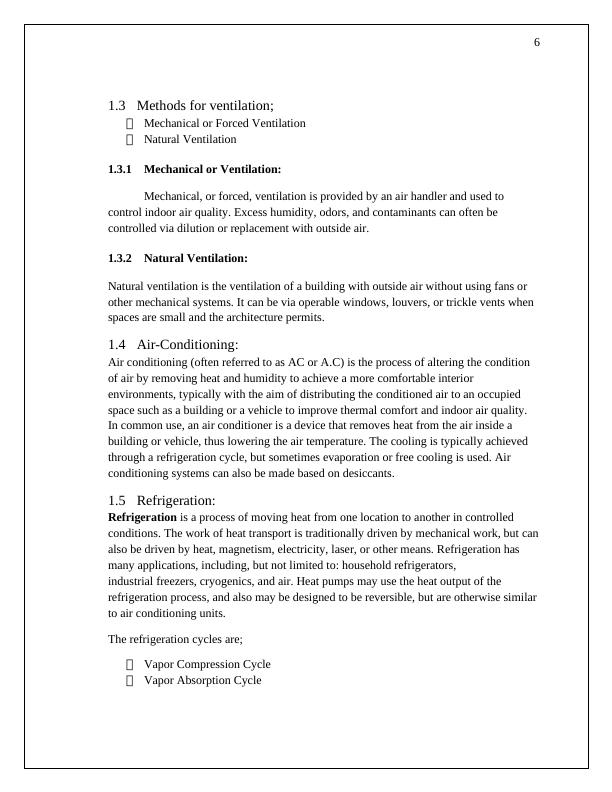
7
2 History of HVACR systems
HVACR systems first used only to preserve food. Most evidence indicates that the
Chinese were the first to store natural ice and snow to cool wine and other delicacies.
Evidence has been found that ice cellars were used as early as 1000 B.C. in China.
Figure 2.1 Ice cells were used to preserve food.
Early Greeks and Romans also used underground pits to store ice, which they covered
with straw, weeds, and other materials to provide insulation and preserve it over a
long period
Ancient people of Egypt and India cooled liquids in porous earthen jars. These jars were
set in the dry night air, and the liquids seeping through the porous walls evaporated to
provide the cooling.
Some evidence indicates that ice was produced due to the vaporization of water through
the walls of these jars, radiating heat into the night air.
In the eighteenth and nineteenth centuries, natural ice was cut from lakes and ponds in the
winter in northern climates and stored underground for use in the warmer
months. Some of this ice was packed in sawdust and transported to southern
states to be used for preserving food. In the early twentieth century, it was still
common in the northern states for ice to be cut from ponds and then stored in open
ice houses. This ice was insulated with sawdust and delivered to homes and
businesses.
2 History of HVACR systems
HVACR systems first used only to preserve food. Most evidence indicates that the
Chinese were the first to store natural ice and snow to cool wine and other delicacies.
Evidence has been found that ice cellars were used as early as 1000 B.C. in China.
Figure 2.1 Ice cells were used to preserve food.
Early Greeks and Romans also used underground pits to store ice, which they covered
with straw, weeds, and other materials to provide insulation and preserve it over a
long period
Ancient people of Egypt and India cooled liquids in porous earthen jars. These jars were
set in the dry night air, and the liquids seeping through the porous walls evaporated to
provide the cooling.
Some evidence indicates that ice was produced due to the vaporization of water through
the walls of these jars, radiating heat into the night air.
In the eighteenth and nineteenth centuries, natural ice was cut from lakes and ponds in the
winter in northern climates and stored underground for use in the warmer
months. Some of this ice was packed in sawdust and transported to southern
states to be used for preserving food. In the early twentieth century, it was still
common in the northern states for ice to be cut from ponds and then stored in open
ice houses. This ice was insulated with sawdust and delivered to homes and
businesses.

8
3 Technological Advancements in HVACR
HVAC systems are increasingly communicating between the indoor and outdoor
controls while also reducing heat loss and maximizing dehumidifying processes. The
systems also run quieter and are easier to use with touch screen, programmable
thermostats with multiple settings.
These new technological advancements are made possible because
interconnection is at an all-time high. The ability to communicate with our
machines is becoming simpler every day.
While there are some definitive changes in the HVAC components and controls
themselves, some external technologies are also helping to take that efficiency to
even another level.
The driving forces behind these technological advancements are
Improving efficiency
Lessening the strain on both the grid and the
environment Increasing the comfort of rooms in a
home or building.
3.1 Technological Advancements
3.1.1 Learning Thermostat
One of the primary recent advancements in the HVAC industry is the Learning
Thermostat, which is almost a virtual assistant as shown in the figure 3.1. It learns
what temperatures we like and it automatically adjusts the room we are in to our
settings. This Learning Thermostat turns itself off when we leave the room. It is
controllable by Wi-Fi so we can warm up your bathroom before we take a shower
each day (unless the Learning Thermostat has already figured out us like the
bathroom warmer at that time of day) or cool off the house before we get home
from work. The Learning Thermostat also has the ability to turn off during times of
peak demand. This means we save money. With the Learning Thermostat, the
process is completely automated.
3 Technological Advancements in HVACR
HVAC systems are increasingly communicating between the indoor and outdoor
controls while also reducing heat loss and maximizing dehumidifying processes. The
systems also run quieter and are easier to use with touch screen, programmable
thermostats with multiple settings.
These new technological advancements are made possible because
interconnection is at an all-time high. The ability to communicate with our
machines is becoming simpler every day.
While there are some definitive changes in the HVAC components and controls
themselves, some external technologies are also helping to take that efficiency to
even another level.
The driving forces behind these technological advancements are
Improving efficiency
Lessening the strain on both the grid and the
environment Increasing the comfort of rooms in a
home or building.
3.1 Technological Advancements
3.1.1 Learning Thermostat
One of the primary recent advancements in the HVAC industry is the Learning
Thermostat, which is almost a virtual assistant as shown in the figure 3.1. It learns
what temperatures we like and it automatically adjusts the room we are in to our
settings. This Learning Thermostat turns itself off when we leave the room. It is
controllable by Wi-Fi so we can warm up your bathroom before we take a shower
each day (unless the Learning Thermostat has already figured out us like the
bathroom warmer at that time of day) or cool off the house before we get home
from work. The Learning Thermostat also has the ability to turn off during times of
peak demand. This means we save money. With the Learning Thermostat, the
process is completely automated.
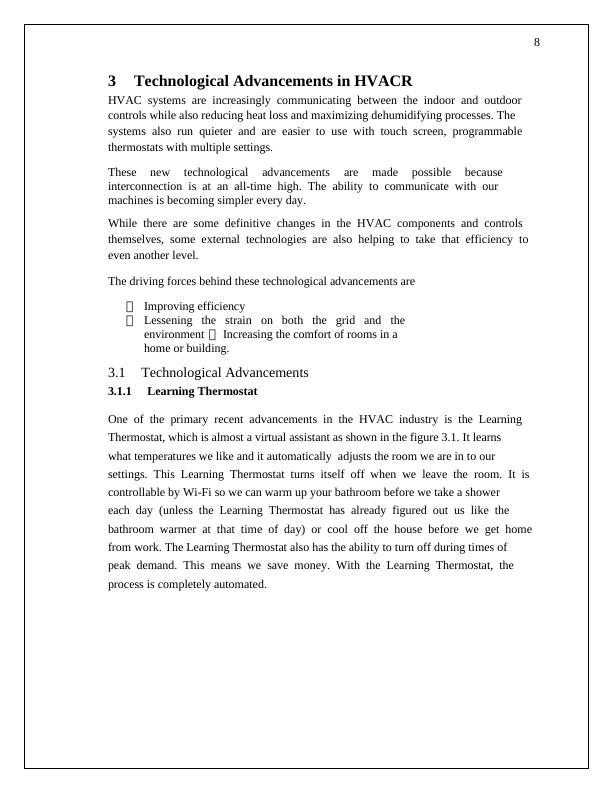
End of preview
Want to access all the pages? Upload your documents or become a member.
Related Documents
A Report on Masters of Engineering: Variable Refrigerant Flow System (VRF)lg...
|58
|18640
|47
HVAC and Fire Protection in Building Safetylg...
|11
|2840
|312
Integrate Sustainability in ICT Planning and Design Projectslg...
|40
|4830
|479
(PDF) An Investigation of Air Conditioning System Diagnosislg...
|15
|2803
|245
Level 2 NVQ General Health and Safety Study Materiallg...
|12
|2489
|447
Food Drying Solution 2022lg...
|56
|14996
|17